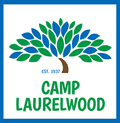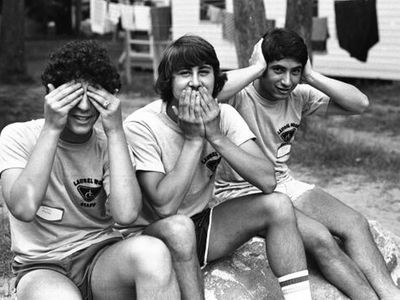History
Beginning - 1931
From 1931 to 1936, and inspired by a Jewish camp in Massachusetts, Camp Laurelwood began as a day camp facility. But after 1936, the rapidly growing operation no longer fit its rented space along the Pine River in Northford, Connecticut. After an exhaustive survey to find a suitable permanent location, the current property in North Madison, Connecticut was purchased.
Camp Laurelwood started with no money in the bank; it had only the spirit, devoted service and will of self-sacrificing men and women, to provide deserving Jewish children from New Haven the benefits of a summer camp experience. A $1,000 loan from the New Haven Jewish Community Center covered more than one-third of the $2,850 purchase price for the North Madison property.
Tents were staked out to house the children, camp director and staff - one side of the road for girls and the other for boys. The first essential need was drinking water, which was obtained by driving a 200-foot deep well into the bedrock. The dining hall from the rented location in Northford was disassembled, transported to North Madison, and erected on a new foundation. Part of the building was used for a small office.
1950s - the "T" Pool
During the 1950s Camp Laurelwood looked to begin construction on a pool, regularly called the “T” pool. Given the board’s fundraising success and the excitement of the greater Jewish community in New Haven for the pool project, Camp Laurelwood quickly raised the $35,000 required to build both the pool and the adjoining shower house facilities.
However, swimming pools that large require thousands of gallons of water, which Camp Laurelwood did not have in abundance. Borrowing a page from an old dime-novel, Board President Milton Holiner hired a local “diviner” named Mrs. Chandler who used a forked tree branch found on Main Campus to locate additional ground water. After a few dry holes dug, she successfully located a spring with an abundant supply of water.
Thus, in the summer of 1960 - and with a fresh well pumping water - Camp Laurelwood opened its newest place to stay cool.
Late 20th century to today
Before the Chuppa was built, the Rec Hall was the official camp gathering place. And for many years, it was like a museum with Big “O” flags from years past hanging from its rafters.
The Rec Hall hosted Shabbat services, rainy day movies, camp socials, theatrical productions, and even served as a barbershop in the 1960s. During chilly summer evenings, counselors and staff often huddled in front of a roaring fire set in its massive fieldstone fireplace.
For over 80 years, Camp Laurelwood has operated as the premier overnight Jewish summer camp in Connecticut. At Laurelwood, from the moment a camper arrives, they are immersed in the decades long traditions that allow campers to feel a part of the Laurelwood family. This connection to Laurelwood lasts a lifetime, making Laurelwood a place you can always call home.
Reflections
By Lisa “Sid” Sidella:
Counselor: 1983-1985, 1987; Waterfront Director: 1990-1995
My first summer at Camp was the first time I was away from home for more than one week. I was the new kid - I didn’t know anyone until another girl sat next to me on the Mess Hall steps while everyone else was greeting each other with laughter, hugs, and tears. She looked at me and said, “You must be new here. My name is Jill.” It was the beginning of a new me - my first summer as a Laurelwood counselor.
Not only was I able to make lifetime friends, learn a new culture and embrace its beautiful people, I was able to play with kids all day! I spent my summers without a care, helping many young people through the trials and tribulations of being a teenager.
After four Laurelwood summers it was time to figure myself out- what could I do where I play with kids all year and work at Camp in the summer??? One day after camp was over for the summer, my mother effortlessly offered, “Teach.”
As I prepare to enter my 20th year in Education (after 10 years at Laurelwood), I realize my true passion for teaching was sparked in those first few years at Camp Laurelwood.
By Jake Honig:
Camper 2004-2006; Staff Member 2007.
No matter where I go or who I meet, I have trouble not comparing new experiences to my time at Camp Laurelwood. As a freshly-minted New York City-based filmmaker, I have learned there is perhaps nothing more important than building your own sense of community. It’s a big city, and it’s easy to get lost.
Entering that unknown world was almost as scary as entering 463 Summer Hill Road for the first time - you know, that feeling of foreboding and sheer panic. Will I fit in here? Will I make any friends? Will people think my haircut is stupid? But despite my first few floundering years in the city - in which I tried on different personas in an effort to “blend” - I soon realized that the world of entertainment has a great deal in common with the Laurelwood campus. That is, people appreciate when you are yourself; you don’t need a contrived style or swagger to fit in. People welcome honesty and humility over everything and want to know who you are at your core.
My years at Laurelwood undoubtedly shaped my hunger for new experiences and friendship. Without my time there, I know acclimating to life in the New York entertainment industry would have never been so smooth.
By Leah Margolis Nathan:
Camper 1992-1996; Staff Member 1998-2001, 2003.
With my last summer at the ‘Plex behind me, like most, I still wasn’t quite ready to say goodbye to Summer Hill Road. So instead, I opted to follow in my mother’s footsteps as an Arts & Crafts counselor.
My weeks on Main Campus - next to the Infirmary - were spent with the usual beads and lots of gimp. We did have our frustrating moments, like cleaning up after a rowdy bunk of boys who clearly would have rather been at the ropes course. But it was the moments in which we contributed, playing a role in camp’s memorable events, that I cherished the most. Whether it was a sign to recognize an important event (like pajama breakfast) or helping to decorate for the banquet, I knew that our contributions were not only appreciated but that they played an important role in the outcome of the event: we were “setting the stage” for the day or evening activity and helping to make each camper’s experience memorable.
Today, as a designer, I continue to set backdrops for people to create their own memories. And, had I not seen the joy in the campers’ eyes when they walked into the Mess Hall on banquet night, perhaps I never would have followed that path.

